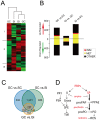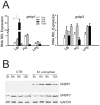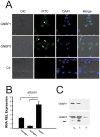Altered immunity in crowded locust reduced fungal (Metarhizium anisopliae) pathogenesis
- PMID: 23326229
- PMCID: PMC3542111
- DOI: 10.1371/journal.ppat.1003102
Altered immunity in crowded locust reduced fungal (Metarhizium anisopliae) pathogenesis
Abstract
The stress of living conditions, similar to infections, alters animal immunity. High population density is empirically considered to induce prophylactic immunity to reduce the infection risk, which was challenged by a model of low connectivity between infectious and susceptible individuals in crowded animals. The migratory locust, which exhibits polyphenism through gregarious and solitary phases in response to population density and displays different resistance to fungal biopesticide (Metarhizium anisopliae), was used to observe the prophylactic immunity of crowded animals. We applied an RNA-sequencing assay to investigate differential expression in fat body samples of gregarious and solitary locusts before and after infection. Solitary locusts devoted at least twice the number of genes for combating M. anisopliae infection than gregarious locusts. The transcription of immune molecules such as pattern recognition proteins, protease inhibitors, and anti-oxidation proteins, was increased in prophylactic immunity of gregarious locusts. The differentially expressed transcripts reducing gregarious locust susceptibility to M. anisopliae were confirmed at the transcriptional and translational level. Further investigation revealed that locust GNBP3 was susceptible to proteolysis while GNBP1, induced by M. anisopliae infection, resisted proteolysis. Silencing of gnbp3 by RNAi significantly shortened the life span of gregarious locusts but not solitary locusts. By contrast, gnbp1 silencing did not affect the life span of both gregarious and solitary locusts after M. anisopliae infection. Thus, the GNBP3-dependent immune responses were involved in the phenotypic resistance of gregarious locusts to fungal infection, but were redundant in solitary locusts. Our results indicated that gregarious locusts prophylactically activated upstream modulators of immune cascades rather than downstream effectors, preferring to quarantine rather than eliminate pathogens to conserve energy meanwhile increasing the "distance" of infectious and target individuals. Our study has obvious implications for bio-pesticides management of crowded pests, and for understanding disease epidemics and adaptiveness of pathogens.
Conflict of interest statement
The authors have declared that no competing interests exist.
Figures







Similar articles
-
Variation of TNF modulates cellular immunity of gregarious and solitary locusts against fungal pathogen Metarhizium anisopliae.Proc Natl Acad Sci U S A. 2022 Feb 8;119(6):e2120835119. doi: 10.1073/pnas.2120835119. Proc Natl Acad Sci U S A. 2022. PMID: 35110413 Free PMC article.
-
Crowded locusts produce hatchlings vulnerable to fungal attack.Biol Lett. 2009 Dec 23;5(6):845-8. doi: 10.1098/rsbl.2009.0495. Epub 2009 Aug 12. Biol Lett. 2009. PMID: 19675004 Free PMC article.
-
Interaction between Paranosema locustae and Metarhizium anisopliae var. acridum, two pathogens of the desert locust, Schistocerca gregaria under laboratory conditions.J Invertebr Pathol. 2008 Mar;97(3):203-10. doi: 10.1016/j.jip.2007.10.002. Epub 2007 Oct 10. J Invertebr Pathol. 2008. PMID: 18005982
-
Host-Pathogen Interactions between Metarhizium spp. and Locusts.J Fungi (Basel). 2022 Jun 3;8(6):602. doi: 10.3390/jof8060602. J Fungi (Basel). 2022. PMID: 35736085 Free PMC article. Review.
-
Biological control of locusts and grasshoppers.Annu Rev Entomol. 2001;46:667-702. doi: 10.1146/annurev.ento.46.1.667. Annu Rev Entomol. 2001. PMID: 11112183 Review.
Cited by
-
CRISPR-based herd immunity can limit phage epidemics in bacterial populations.Elife. 2018 Mar 9;7:e32035. doi: 10.7554/eLife.32035. Elife. 2018. PMID: 29521625 Free PMC article.
-
A double-agent microRNA regulates viral cross-kingdom infection in animals and plants.EMBO J. 2025 May;44(9):2446-2472. doi: 10.1038/s44318-025-00405-4. Epub 2025 Mar 5. EMBO J. 2025. PMID: 40045022 Free PMC article.
-
HMG-Like DSP1 Mediates Immune Responses of the Western Flower Thrips (Frankliniella occidentalis) Against Beauveria bassiana, a Fungal Pathogen.Front Immunol. 2022 Apr 5;13:875239. doi: 10.3389/fimmu.2022.875239. eCollection 2022. Front Immunol. 2022. PMID: 35450074 Free PMC article.
-
Action on the Surface: Entomopathogenic Fungi versus the Insect Cuticle.Insects. 2013 Jul 16;4(3):357-74. doi: 10.3390/insects4030357. Insects. 2013. PMID: 26462424 Free PMC article. Review.
-
Phase-related differences in egg production of the migratory locust regulated by differential oosorption through microRNA-34 targeting activinβ.PLoS Genet. 2021 Jan 6;17(1):e1009174. doi: 10.1371/journal.pgen.1009174. eCollection 2021 Jan. PLoS Genet. 2021. PMID: 33406121 Free PMC article.
References
-
- Rolff J, Siva-Jothy MT (2003) Invertebrate ecological immunology. Science 301: 472–475. - PubMed
-
- Pener MP, Simpson SJ (2009) Locust Phase Polyphenism: An Update. Adv Insect Physiol 36: 1–272.
-
- Srygley RB (2012) Age- and Density-Dependent Prophylaxis in the Migratory, Cannibalistic Mormon Cricket Anabrus simplex (Orthoptera: Tettigoniidae). Environ Entomol 41: 166–171. - PubMed
Publication types
MeSH terms
LinkOut - more resources
Full Text Sources
Other Literature Sources

